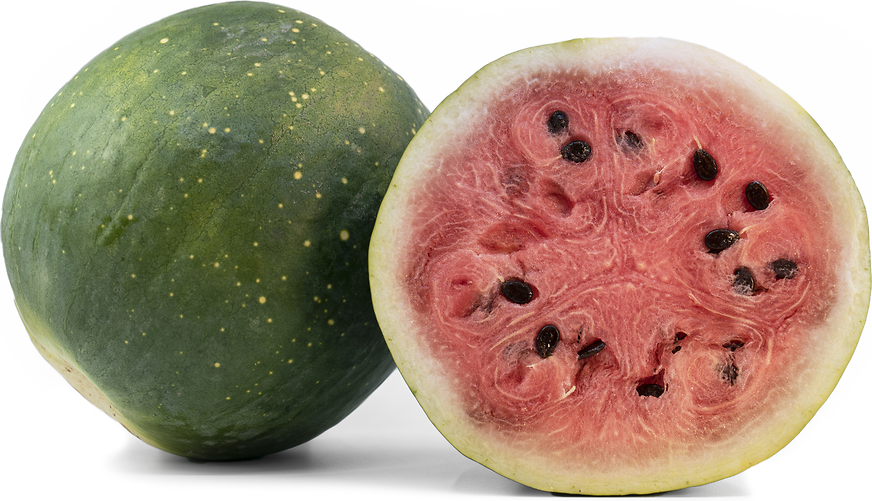


Moon and Stars Watermelons
Estimated Inventory, lb : 0
Description/Taste
Moon and Stars is a heavy variety of watermelon, weighing anywhere from 320 to 800 ounces. It can be grown in a round or oblong shape and reaches around 38 centimeters in length. The thick rind of Moon and Stars watermelon is dark green and speckled with various-sized yellow blotches. Its leaves are also dark green with yellow spots. When sliced in half, the rind of this watermelon looks white or very light green and surrounds its succulent flesh. Depending on the variety, the flesh can be red, dark pink, or yellow. Moon and Stars watermelon has large brown seeds that become more mealy as it ripens. Its scent is sweet and subtly floral. Moon and Stars watermelon has an intensely sweet flavor due to its high sugar levels.
Seasons/Availability
Moon and Stars watermelon is available in the summer.
Current Facts
The botanical name for Moon and Stars watermelon is Citrullus lanatus and it belongs to the Cucurbitaceae family. This variety gets its name from the interstellar markings on its rind. Some of the most common varieties include Cherokee Moon and Stars watermelon, Long Milky Way Moon and Stars, Pink Flesh Amish Moon and Stars, Yellow Flesh Moon and Stars, and Van Doren’s Moon and Stars. The watermelon species is commonly considered a fruit, though it has vegetable-like qualities as well. This is because it belongs to the gourd family, which includes cucumbers, squash, and pumpkins. Watermelon can be categorized into four groups: seeded, seedless, icebox, and yellow/orange. Moon and Stars fall into the seeded category.
Nutritional Value
While the specific nutritional value of Moon and Stars watermelon is not widely documented, watermelon is known for being a source of vitamins A and C. These vitamins are important for vision, immune function, skin health, and protection against cell damage. It also contains L-citrulline, a nutrient that may improve artery function, circulation, and muscle oxygenation. Watermelon contains fiber and prebiotics, which help support gut health, good bacteria growth, mineral absorption, blood sugar control, and may potentially protect against colon cancer. Watermelon is high in lycopene, an antioxidant that may reduce the risk of type 2 diabetes, Alzheimer's, and heart disease. It has potassium, a nutrient that helps maintain proper hydration and electrolyte balance, regulates blood pressure, and reduces the risk of hypertension. Drinking watermelon juice before a workout may decrease muscle soreness.
Applications
Moon and Stars watermelon can be eaten fresh or cooked and used interchangeably with other watermelon varieties in recipes. Raw Moon and Stars watermelon can be sliced, scooped into melon balls, or transformed into crinkle-cut watermelon fries. It's not considered a good juicing melon because of its relatively high seed content. Fresh Moon and Stars watermelon can be used in salads, kabobs, crudités, salsas, smoothies, cocktails, sorbets, and popsicles. It can be used as a topping for pizzas, sandwiches, burgers, pasta, tarts, bruschetta, and poké bowls. The rinds are sometimes dried, roasted, stewed, pickled, or used in stir-fries, especially in the Middle East and Asia. Moon and Stars watermelon can be cut in half, hollowed out, and used to cook a chicken inside of it. Moon and Stars watermelon pairs well with ingredients like arugula, spinach, mint, basil, cilantro, jalapeños, oranges, lemons, limes, olives, tomatoes, cucumbers, onions, kiwi, raspberries, blueberries, feta or goat cheese, parmesan, pesto, shrimp, and sausage. Moon and Stars watermelons will keep for up two weeks in the refrigerator.
Ethnic/Cultural Info
Moon and Stars watermelon was released in the 1920s by Peter Henderson & Co. Its seeds were initially given to the company by a melon grower in Colorado. Though the watermelon gained some popularity in the mid-1900s, it became relatively obscure until the Seed Savers Exchange had a renewed interest in finding the seed in the 1970s. A woman named Merle Van Doren reached out in the early 1980s to let them know that she had been growing this variety on her farm in Macon, Missouri for years and provided them with the seeds. New varieties like the Amish Moon & Stars and a less sweet yellow-fleshed type were developed by the late 1980s. Though Moon and Stars watermelon was developed in the United States, the first watermelon likely came from Egypt over 5,000 years ago. Ancient Egyptian limestone paintings depicting the fruit, along with tombs containing watermelon seeds and leaves, have been discovered. Watermelon was traded in Northern Africa, the Near East, and the Middle East for centuries, eventually reaching India in the 9th century and China through Silk Road trade in the 10th century. The Moors, Muslim people inhabiting Mediterranean regions of Europe, introduced watermelon to other areas of Southern Europe during the Middle Ages, and by the 12th century, the fruit had arrived in Hungary.
Geography/History
Moon and Stars watermelon is native to the United States, where it was introduced in the 1920s. It stems from the original watermelon species that are native to northeastern Africa. Moon and Stars watermelon grow in warm climates with lots of sun and water. Because Moon and Stars watermelon is a cultivated variety bred for its unique appearance, it’s not found in the wild. It's instead grown commercially and in home gardens. After being introduced to the public in the early 20th century, Moon and Stars watermelon became relatively obscure within a few decades. It was not until its re-release in the 1980s by Merle Van Doren of Macon, Missouri that this variety became popular again. Moon and Stars watermelon remains a relatively uncommon variety, though it may be found in some farmers' markets and specialty stores. Since many different companies sell Moon and Stars Watermelon seeds, melon enthusiasts may also grow this variety in their home gardens.




